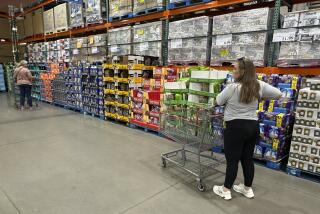Warm Winter, Tireless Consumer Spur Growth
WASHINGTON — The warmest January in more than a century lured consumers out to the shopping malls to spend money at the fastest clip in six months, boosting the economy as the new year began.
The nation’s factories also have been enjoying good times, with a closely watched gauge of manufacturing activity posting a strong increase in February.
But despite the warm weather, construction spending grew far less than expected in January as home building, a standout performer for years, managed only a tiny increase.
Still, analysts said the various reports released Wednesday pointed to an economy that is shaking off blows from the hurricanes and soaring energy prices in the latter half of 2005 to grow at a solid pace in the first quarter of this year.
The Commerce Department reported that personal spending surged 0.9% in January, the biggest advance in six months, reflecting strong demand for both durable and nondurable goods.
Personal income rose a solid 0.7% in January. That reflected solid wage growth during the month and several special factors, including a 4.1% cost-of-living increase for Social Security recipients and the start of the government’s prescription drug benefit. Without the special factors, personal income would have risen a smaller 0.4%.
Economists said the strong gain in spending meant overall economic growth, which slowed to a 1.6% rate in the October-December period, was rebounding strongly, possibly surpassing 5%, in the current quarter.
Also boosting the economy is a resurgent manufacturing sector, which was hit hard in the 2001 recession. The Institute for Supply Management reported that its closely watched manufacturing gauge rose to a three-month high of 56.7 in February, up from 54.8 in January, as the index for new orders jumped to the highest level in 16 months.
However, a third report showed that construction spending managed only a 0.2% increase in January, far below the 1% that analysts had been expecting.
A big reason for the slowdown was a tiny 0.1% increase in private home building, the poorest monthly performance since an actual decline of 0.4% in June. It was a further indication that residential construction, which has enjoyed five boom years, is slowing.
The bigger rise in spending in January compared to incomes kept the personal savings rate in negative territory at minus 0.7%. That meant Americans spent more than their after-tax incomes, which forced them to dip into their savings or increase borrowing.
For 2005, the savings rate registered a negative 0.4%, the first time the rate has been in negative territory for an entire year since the Great Depression.
More to Read
Inside the business of entertainment
The Wide Shot brings you news, analysis and insights on everything from streaming wars to production — and what it all means for the future.
You may occasionally receive promotional content from the Los Angeles Times.










